This blog entry consists of a youtube video:
By Steve Miller (CIRA)
This blog entry is in Powerpoint show format, click on the link below to view the Powerpoint show:
A strong cold front pushed southward across the Plains during the day on November 10, 2014. The temperature gradient across the front was quite dramatic, as seen by the surface observations at 23:00 UTC:
Visible imagery from GOES-East during the afternoon hours centered over Colorado clearly showed the southward progress of the cold front as dust was being lofted at the edge of the cold front where surface winds are strongest:
Note the rapid movement of the cold front as it moves from southeast Colorado towards northeast New Mexico as you can easily trace it by the blowing dust.
The GOES-West shortwave albedo product also clearly shows the blowing dust:
Confirming the existence of the dust is this webcam along I-25 at Raton Pass (along the New Mexico / Colorado border):
Another interesting aspect of this event are the deep-tropospheric gravity waves created by the leeside cold front. The GOES water vapor imagery shows narrow bands coincident with the cold front as it moves southward immediately to the lee of the Rockies:
Relatively strong vertical motion exists along these narrow bands in a broad zone through the upper troposphere and into the lower stratosphere. The resulting vertical displacements are up to 1 km, making them appear in the water vapor imagery.
Interestingly enough, the synthetic water vapor imagery from the 4-km NSSL WRF-ARW model also depicts these narrow bands associated with the leeside cold front:
The model was too slow with the leeside cold front, and this is a known model bias due to sharp inversions that exist with shallow arctic fronts.
For more information on leeside cold fronts and their appearance in water vapor imagery see:
Ralph, F.M., P.J. Neiman, and T.L. Keller, 1999: Deep-Tropospheric Gravity Waves Created by Leeside Cold Fronts. J. Atmos. Sci., 56, 2986-3009.
One of the exciting new products that will be available on GOES-R is the split window difference (SWD) which is simply the difference between the 10.35 micron and 12.3 micrometer channels. This channel difference has been shown to provide information about atmospheric column water vapor. Higher SWD values (larger positive difference) can correspond to deepener low-level moisture in a cloud-free environment. This signature can be utilized to anticipate where and when convective initiation will occur in cloud-free conditions away from complex terrain (such as the Great Plains). Although similar bands were available on some previous GOES instruments, their coarse resolution and poor signal-to-noise ratio made them less useful for identifying subtle small-scale features in the low level moisture field.
In order to demonstrate this product (since the 12.3 micron channel is not available on the current GOES imager), we use synthetic imagery from the 4-km NSSL WRF-ARW model. Here is an example of the SWD on a day with a dryline across Texas:
The larger (positive difference) values of SWD are shown in warm colors, while the location of the cross section (shown below) is illustrated by the east-west oriented black line. Next, we will look at output from the NSSL WRF-ARW model along the cross section line:
The white line indicates SWD values (scale on the right) while the colors are specific humidity. SWD values are greatest along the dryline where the depth of the moisture is greatest. The low-level temperature lapse rate also plays a role in the SWD, but as can be seen in the cross section, the depth of the moisture is the dominating factor.
A loop of the synthetic SWD from the NSSL WRF-ARW:
shows the animation from 1500 – 0000 UTC at hourly intervals from the model. On the left is the synthetic IR (10.35 micron) band and on the right is the synthetic SWD product (larger SWD values are shown in warmer colors).
The first thing to note is the skies are clear before convective initiation across Texas which is necessary to make use of the product in this way. The larger SWD values develop along the dryline prior to convective initiation. Keep in mind this synthetic data is at hourly intervals, but once GOES-R becomes available, the data will be displayed at 5 (or even 1) minute intervals.
We can preview how this data may appear on GOES-R by looking at an example from the MSG (Meteosat Second Generation) SEVERI instrument over Europe. An event occurred on 6 July 2012 where convection developed along a convergence boundary under clear skies prior to initiation. Also, this event occurred over flat terrain (Poland) which is important since complex terrain complicates this signature.
Here is the zoomed in visible imagery (over Poland) from the MSG satellite from 0845 – 1500 UTC 6 July 2012:
The key to note is the clear skies prior to convective initiation.
Here is the zoomed in SWD imagery (over Poland) from the MSG satellite over the same time period:
Focus on the clear area (that was shown in the visible image) from the center of the scene southeastward. SWD values gradually increase (going toward warmer colors) indicating deepening moisture along this convergence boundary, followed by convective initiation (expanding regions of blue/purple later in the loop).
A local maximum in SWD developed over a convergence boundary (under clear skies) about 2 hours prior to convective initiation. Forecasters can make use of this information when attempting to predict where / when convective initiation will occur. As looking at this imagery becomes routine with GOES-R for diagnosing convective initiation (under clear skies beforehand), experience with this product will lead to greater forecaster confidence in timing and location of convective initiation.
For more detailed information on this product, see this article:
Lindsey, D.T., Grasso, L., Dostalek, J.F., and J. Kerkmann, 2014: Use of the GOES-R Split-Window Difference to Diagnose Deepening Low-Level Water Vapor. J. Appl. Meteor. Climatol., 53, 2005–2016. http://dx.doi.org/10.1175/JAMC-D-14-0010.1
GOES-14 was operating on super rapid scan operations schedule for May 11, 2014, meaning that images were being taken every 1 minute. This high temporal resolution data will be routinely available for severe weather events with GOES-R, therefore it is beneficial to learn how to maximize the value added by this dataset. SPC issued a moderate risk for portions of Nebraska and Kansas which will be the focus here. The GOES visible imagery from 1838 to 2011 UTC is shown here:
http://ga2.cira.colostate.edu/Lindsey/11may14_g14_vis_loop.gif
To aid in interpretation of this loop, an annotated image is shown:
Around this time, a southwest-northeast oriented cold front was surging southward in western Kansas while a dryline was positioned just east of this cold front where convective initiation occurs in southwest Kansas. An east-west oriented warm front is annotated above, which was slowly moving northward. Moderate instability and high shear existed along the warm front in southeast Nebraska. The warm sector is characterized by cloud streets, parallel to the low-level (southerly) flow while north of the warm front a much more stable air mass exists characterized by stable wave clouds oriented perpendicular to the winds at inversion top level.
Earlier convective initiation occurs in southwest Kansas along the dryline. The high temporal resolution allows one to see multiple updrafts attempting to penetrate the capping inversion and eventually lead to thunderstorm development. The first sign of convective initiation are shadows projected by anvil cirrus.
Further north, in the region delineated with an oval in the annotated image above, we can see attempts at convective initiation along the western portion of the warm front, near the intersecting cold front. Multiple updrafts merge into one dominant updraft region where the supercell develops. Initial motion of these updrafts is towards the northeast, but by the end of the loop as we see one dominant updraft we can already see indications of this storm turning towards the right (east) along the warm front.
For access to real-time GOES SRSO (when available) click here:
A recent post took a look at the CIRA dust products for the widespread blowing dust event across the Southern Plains behind a strong cold front on 27 April. The associated upper-level trough moved into the middle of the nation and became a giant closed low that stalled for days. Figure 1 shows the position of the closed 500 mb low along with an analysis of sea level pressure and NOWRAD radar reflectivity for midweek (0000 UTC on 30 April). The giant upper-level low affected the weather across much of the nation; here we focus on the strong northerly winds on its backside across the plains of eastern Colorado and the Texas and Oklahoma Panhandles.
We will take a closer look at the 2000 UTC time, which is when the Suomi/NPP satellite passed over the area of interest. The surface plot near this time is shown in Figure 2.
The very strong northerly winds, with gusts as high as 70 mph in eastern Colorado, produced intense areas of blowing dust that created very hazardous driving conditions, forcing a number of roads to close during the day (including for a time Interstate 70 in eastern Colorado). A picture taken in the late morning near the intersection of Highway 40 and 287, in eastern Colorado south of I-70, shows the near zero visibility (Figure 3).
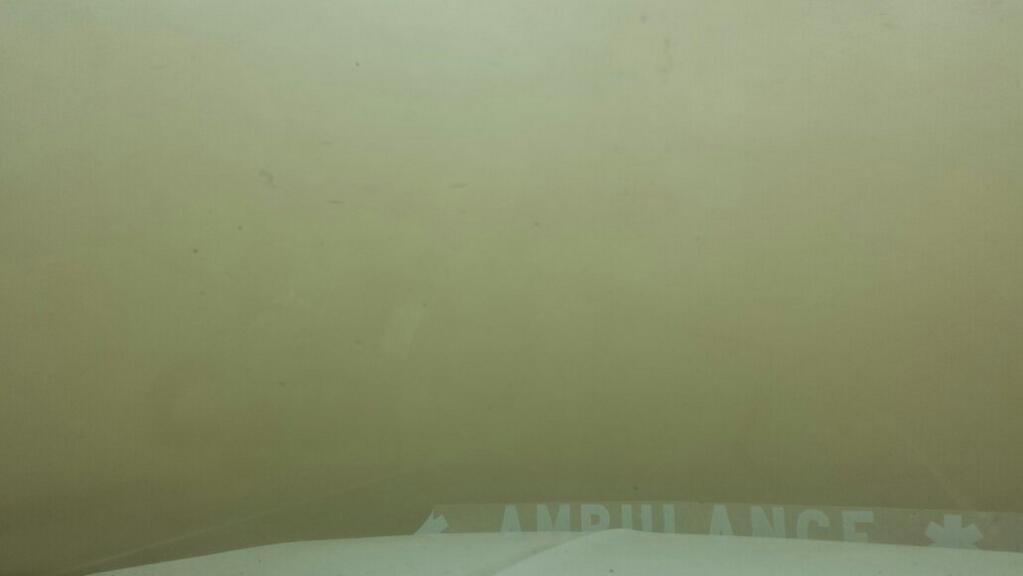
Figure 3. Photo from eastern Colorado in the late morning showing the near zero visibility in blowing dust.
What was particularly interesting about this case, and challenging for forecasters, was the blowing dust being present amidst lots of clouds and even rain (and some snow) showers, as seen in the next two figures showing conditions near 2000 UTC.
Often blowing dust events occur without many clouds present, since the associated airmass is often quite dry (see for example the blog from 27 April). In this case it is certainly difficult to see dust plumes across the eastern Plains of Colorado amidst all the cloudiness, or farther to the south, given all the cloudiness. Did the CIRA dust products help in this regard? First we will focus on eastern Colorado, then shift farther to the south centering on the Texas Panhandle, all for the 2000 UTC Suomi/NPP pass. As noted in previous blogs, Polar orbiting satellites have higher spatial resolution but limited time resolution, but are useful to replicate products that will be available at both high spatial and time resolution in the GOES-R era. In Figure 6 a True Color visible image is shown, followed by the CIRA Pink Dust product in Figure 7.
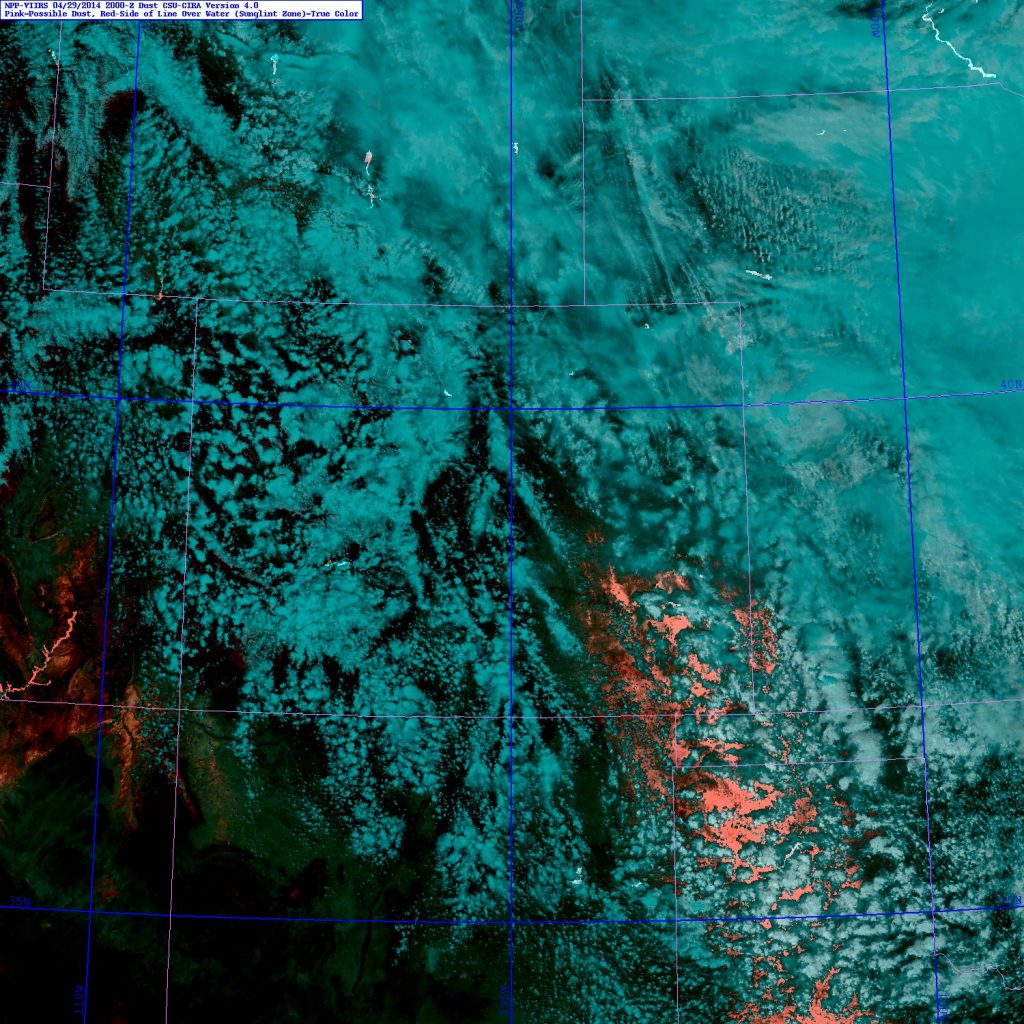
Figure 7. CIRA Suomi/NPP Pink Dust satellite image at 2000 UTC centered on Colorado. Dust appears as pink colors.
The True Color visible image is striking, but the dust is difficult to see, whereas it is much more obvious in the CIRA Pink Dust product in Figure 7. The same is true for the blowing dust farther to the south at this time across the Texas Panhandle, with the dust not so easy to see in the visible True Color image in Figure 8 but very obvious with the CIRA Pink Dust product in Figure 9.
CIRA also has a dust discrimination product using GOES, which allows for much better time resolution than from the Polar satellites, but considerably lower spatial resolution (10 km using a split window technique from GOES sounder data). This type of image for this case at 1945 UTC is shown in Figure 10.
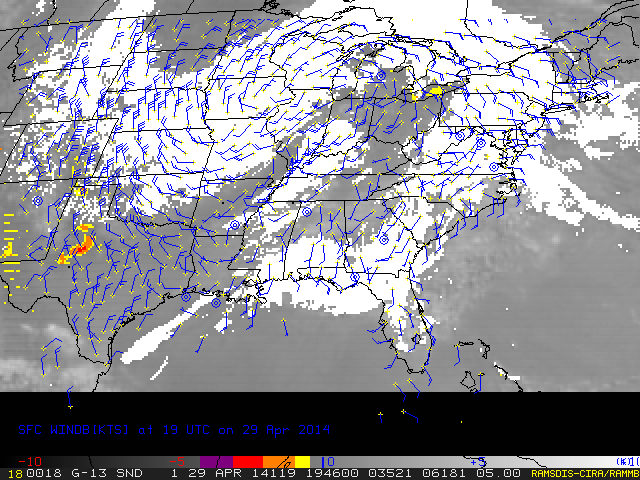
FIgure 10. CIRA dust discrimination product from the GOES sounder data, for 1945 UTC on 29 April. Dust appears as yellow, or red for thicker dust.
With the lower resolution it is not so easy to see the dust amidst the clouds in Figure 10, but the technique does a nice job of showing the dust farther to the south.
You can find more information on this (and other CIRA GOES-R Proving Ground products) product at http://rammb.cira.colostate.edu/research/goes-r/proving_ground/cira_product_list/ The products are available for display in AWIPS I or II; contact CIRA if interested in receiving them.
The extensive outbreak of severe weather on Sunday 27 April (see SPC plot of reports below in Figure 1) made headlines with many destructive tornadoes. A strong cold front associated with an intense low lifting out of the Rockies led to the large outbreak (Figure 2 shows the low at 1200 UTC Monday morning 28 April). Meanwhile very strong winds behind the front produced a large area of blowing dust across the Southern Plains. In this blog entry we will take a look at this dust area through some satellite products designed to highlight blowing dust.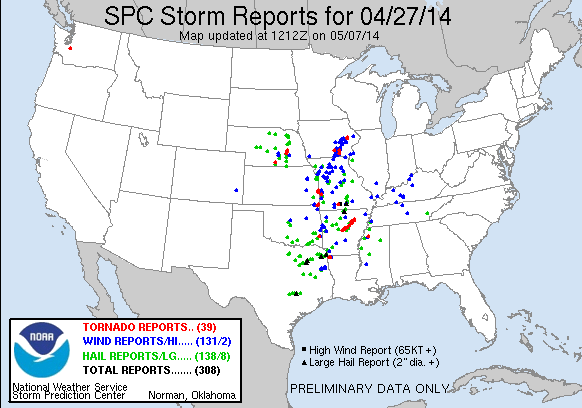
Figure 1. Plot of severe weather reports from the Storm Prediction Center for 27 April.

Figure 2. Surface mslp analysis with fronts at 1200 UTC on Monday 28 April.
First a comparison is made between how the dust storm looked on Sunday afternoon on GOES visible imagery currently on AWIPS and imagery from about the same time from the Suomi/NPP (Polar orbiting) satellite with the VIIRS instrumentation. The products from the Suomi/NPP satellite represent the type of imagery that will be available at high spatial and temporal resolution when the GOES-R satellite is launched. For now the spatial resolution is high (1 km) but the temporal resolution is low, with 2 times that can be shown using VIIRS for this case, one at 1859 UTC and the other at 2038 UTC. Similar looking imagery is also available from the MODIS Aqua and Terra Polar orbiting satellites, but is not shown here as the image swaths are at about the same time.
Images for the first time are shown in Figures 3-5. Figure 3 shows how the dust appears in AWIPS for a GOES visible image at 1852 UTC, overlaid with METAR observations from 1900 UTC. Gusty (30 mph or greater gusts) southwest winds prevail across much of Kansas and Oklahoma, with even strong winds farther west across the High Plains, lifting plumes of dust. Visible imagery from VIIRS with a true color background at 1857 UTC is shown in Figure 4. So much dust is lifted that it looks like we can easily see the plumes in the AWIPS image, and somewhat better in the true color image. It is not always so easy to see where the dust plumes are, however, so CIRA has developed a product that highlights the dust in a pink color (a similar version uses yellow for the dust), and this image is shown also for 1857 UTC in Figure 5. You can find more information on this (and other CIRA GOES-R Proving Ground products) product at http://rammb.cira.colostate.edu/research/goes-r/proving_ground/cira_product_list/ The dust plumes are easily seen in this image, which represents a product that will be available in the GOES-R era. Notice how the southernmost plume of dust in the Texas Panhandle is easily seen, whereas it is not so obvious in the GOES visible image shown in Figure 3.
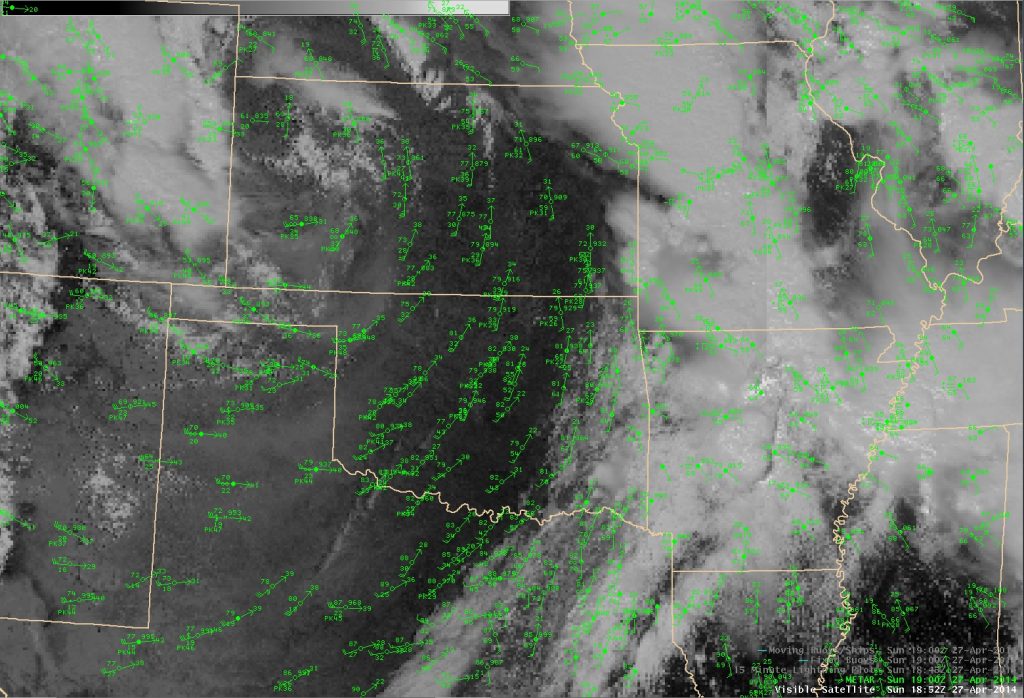
Figure 3. GOES visible image at 1852 UTC on 27 April from AWIPS overlaid with 1900 UTC observations.
The same images are shown for the second available time (2038 UTC). Strong southwest winds continue to prevail across the Southern Plains, with areas of dust discernible in the visible image (Figure 6) across west-central KS and OK and the TX Panhandle. The Suomi/NPP images are shown for two areas in Figures 7-10. For the northern area most of the dust shown in the Pink dust image can also be seen in the two visible images. Figures 9 and 10 show the area farther to the south, and here the CIRA dust product in Figure 10 highlights dust plumes farther to the south that are not so obvious in the AWIPS visible imagery or even the true color image, showing the potential value of such a product.
Dust discrimination imagery can also be created from the current GOES satellites through the GOES sounder, with a split window technique that uses the 10.7 um (more-transparent longwave) and 12.0 um (less-transparent longwave) infrared window bands. The resolution is much lower (10 km) than for images from the Polar satellites (and from what will be available in the GOES-R era), but there is the advantage of hourly time resolution, which means one can loop the imagery. Further description of the imagery and how it is made can be found on the link to the CIRA products page given earlier. An example of this GOES-based dust imagery produced by CIRA for this case is shown in Figure 11 for 1846 UTC and in Figure 12 at 2046 UTC on 27 April. Dust appears as yellow or red (red for thicker dust).
The imagery shown in this example is available now for display in AWIPS I or II; contact CIRA if interested.
In a recent post we showed a dust storm that moved through southeast Colorado and into the Texas Panhandle on 11 March with a strong cold front. Another cold front, even a bit stronger than the one last week, pushed southward through the same area almost exactly one week later as a deepening surface low emerged from the Rockies into the South-Central Plains (see Figure 1 below). Here we will again take a look at the CIRA Proving Ground Pink and Yellow Dust Products from MODIS.
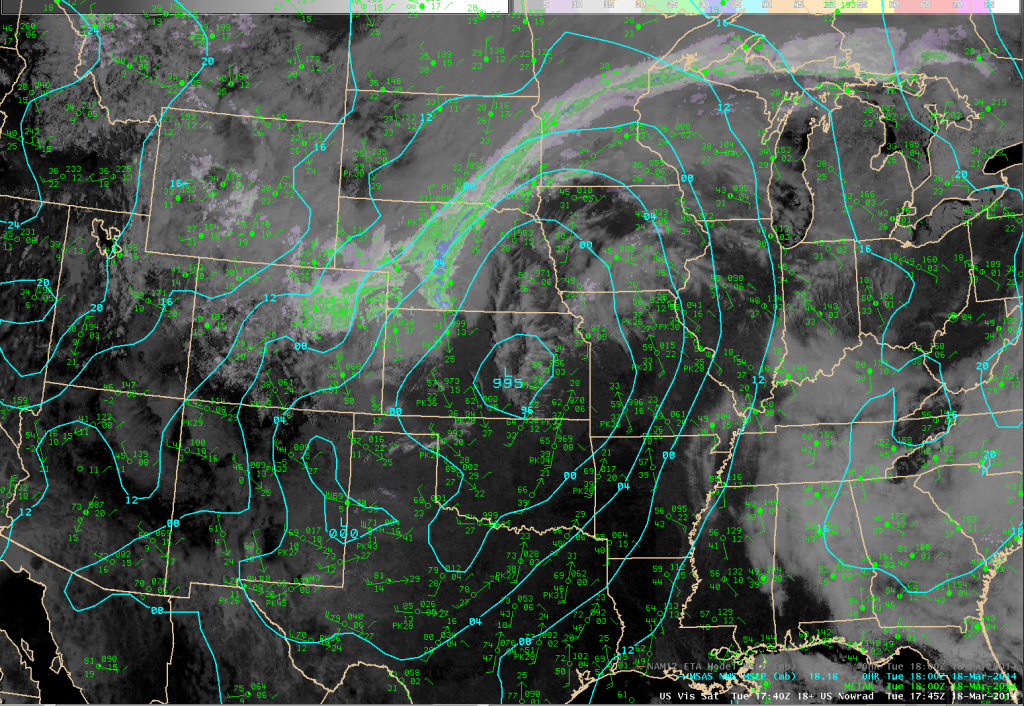
Figure 1. Visible image combined with radar reflectivity at 1745 UTC on 18 March, overlaid with 1800 UTC METAR observations and a pressure (MSLP) analysis.
A closer look at the area of interest is shown in Figures 2 and 3, where we also get a feel for how well the dust showed up in this case with GOES visible satellite imagery.
In the image about the cold front has moved into the Texas Panhandle with a distinct wind shift. Stronger wind gusts exceeding 50 mph are found just to the north in southeastern Colorado, where temperatures have dropped into the 40s. Even colder air lies just to the north, with Limon (at the northern edge of the image) reporting heavy snow. One area of blowing dust is in southeastern Colorado with the stronger winds, although it is not obviously dust from the image above. Another area of dust is seen blowing from west to east ahead of the cold front in the warmer air and dry westerly flow, and this dust is more apparent in the image, as it is in the next image (below) from 30 minutes later.
The next visible image (Figure 4) is from one hour later, and at this time we also have a MODIS pass so we can compare how the dust looks with the two CIRA dust products.
Here are the two dust products for near this time; the “pink” dust product (Figure 5) and the “yellow” dust product (Figure 6).
In both CIRA products the dust is clearly distinguished from the background clouds (which are bluish in the Yellow Dust Product and more cyan colored in the Pink Dust Product). It is especially easy to see the large amount of dust in far southeastern Colorado into the Oklahoma Panhandle with the stronger winds behind the cold front. This particular area of dust continued to consolidate during the afternoon as it pushed southward. A lot of wave structure is seen in the dust, given the horizontal resolution of 1 km in the MODIS-based imagery. Figure 7 shows the visible image at 1900 UTC again with a METAR plot at the same time. The image in Figure 8 is the same for 2000 UTC. We can compare these images with the CIRA dust products from the next MODIS pass at 1948 UTC, in Figures 9 and 10.
The CIRA Dust product images again reveal two areas of blowing dust, a dense area just moving into the Texas Panhandle associated with the stronger northerly winds and sharp cooling behind the cold front. The southern area of dust is still in the same general area as before (near Lubbock, TX (LBB), similar to what occurred a week earlier when they experienced a pre-frontal dust event before a second one behind the cold front). There likely is more blowing dust in southeastern Colorado than is shown in the imagery, but it is obscured by low cloudiness in the colder air well behind the front.
A more recent addition to the Polar orbiting satellites is the Suomi/NPP satellite with the VIIRS instrumentation, which also has the channels needed to make an image similar to the one shown in Figure 10. The pass on this day was at 1946 UTC, and the CIRA pink dust image is shown in Figure 11 below.
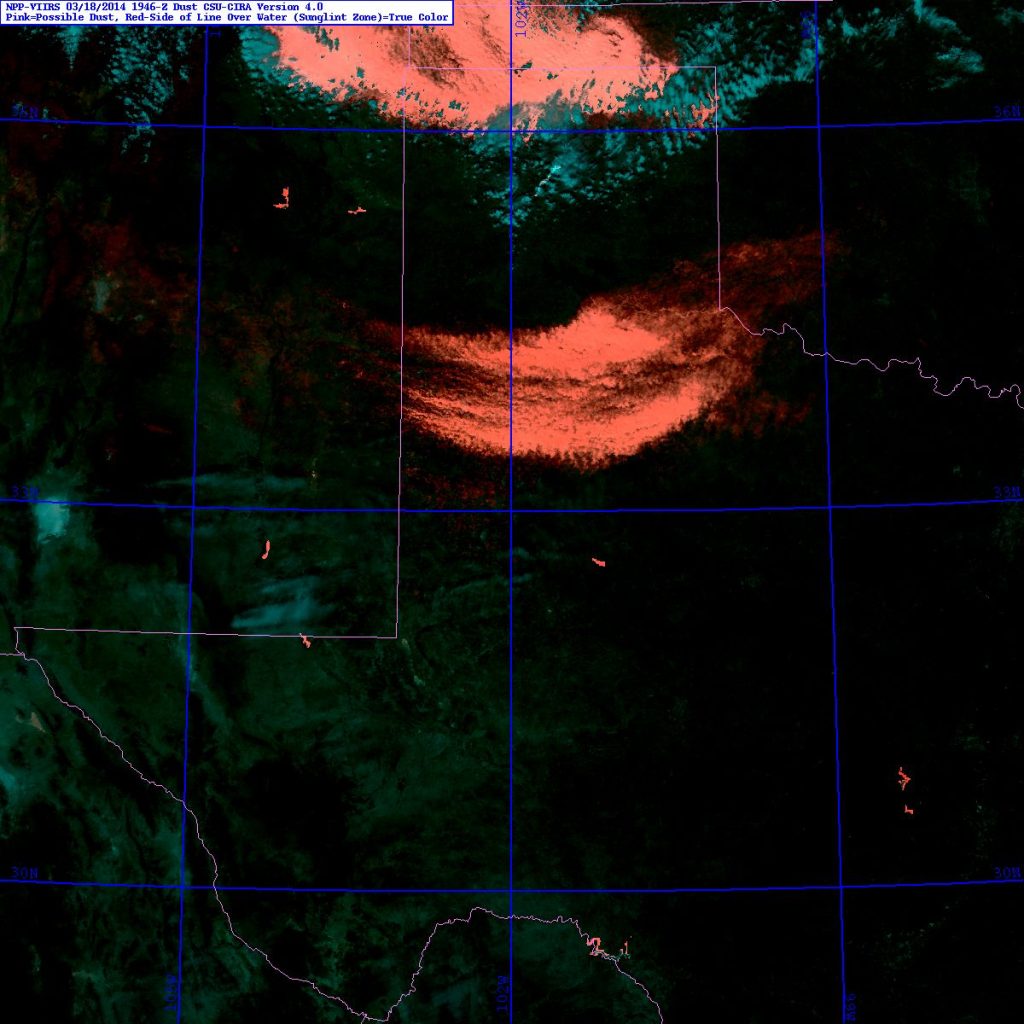
Figure 11. CIRA pink dust image at 1946 UTC from the VIIRS instrument aboard the Suomi/NPP satellite.
The area of dense dust well behind the cold front continued to expand as it moved southward across the Texas Panhandle, becoming a larger scale Haboob that spread through Amarillo (AMA) and LBB, again almost exactly a week after the previous event. Some METAR observations are shown below (Figure 12, from La Junta (LHX) and Figure 13, from Lamar (LAA), both in southeastern Colorado and equally far south, from AMA in Figure 14 (located in the central Texas Panhandle) and then farther south from LBB, in Figure 15).

Figure 12. METAR observations from La Junta (LHX), Colorado from 0853 UTC (bottom) to 2003 UTC (top) on 18 March.

Figure 13. METAR observations from Lamar (LAA), Colorado from 0853 UTC (bottom) to 2003 UTC (top) on 18 March.

Figure 14. METAR observations from Amarillo (AMA), Texas from 1153 UTC/18 March (bottom) to 1153 UTC/19 March (top).
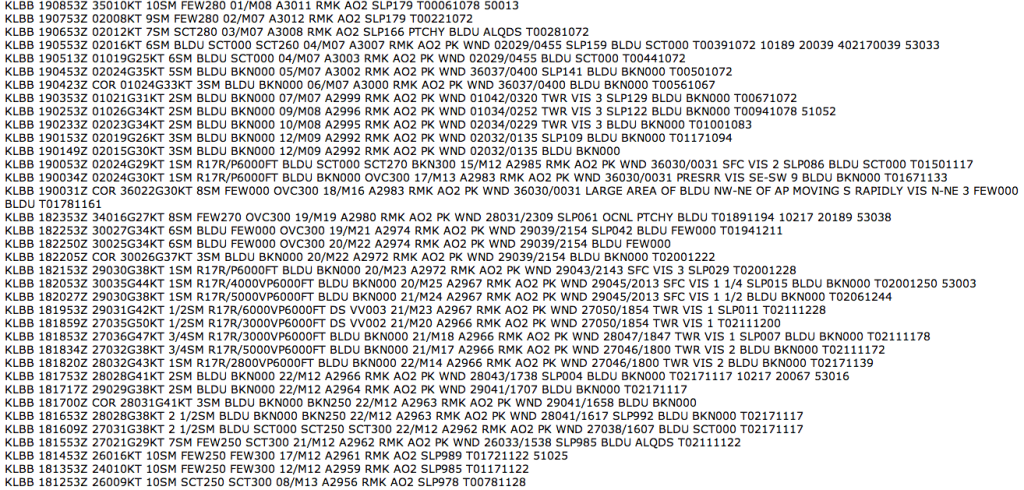
Figure 15. METAR observations from Lubbock (LBB), Texas from 1253 UTC/18 March (bottom) to 0853 UTC/19 March (top).
The various NWS Weather Forecast Offices (WFOs) issued numerous statements, warnings and other graphical products to convey information about the blowing dust, which can be very hazardous to travel when visibilities are suddenly reduced. Below we show a sample of these from north to south. First is a look at the “Weather Story” from the Boulder (BOU) WFO issued on the morning of 18 March, in Figure 16, then moving farther south the same product from the Pueblo (PUB) Colorado WFO in Figure 17.
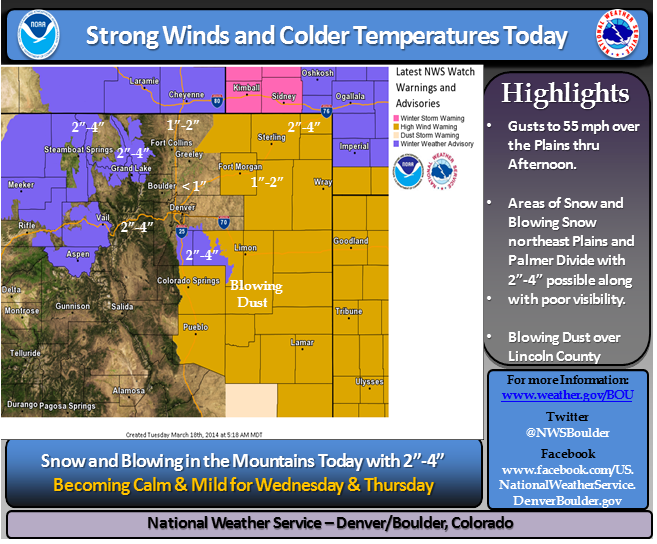
Figure 16. BOU WFO Weather Story graphic conveying information on the blowing dust. Note the snow also in the forecast area.
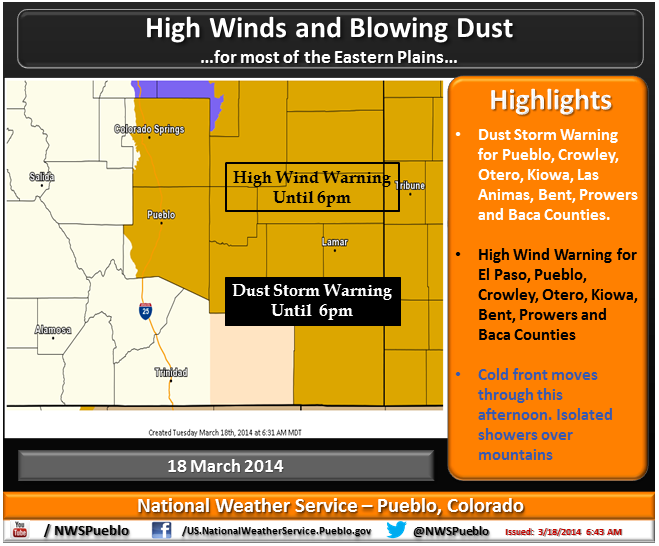
Figure 17. The Pueblo WFO Weather Story graphic shows the area where both a Dust Storm and a High Wind Warning had been issued.
Social media is also used to help convey warnings and other information from a WFO. In Figure 18 is an example of such a product from the AMA WFO, highlighting the area of dust near LBB and the “Wall of dust” approaching from the north. An image posted by NWS personnel from the WFO, along with another image as the dust entered a neighborhood, both from the WFO Facebook page, are shown in Figure 19.
The Weather Story issued by the LBB WFO late in the afternoon on 18 March also nicely describes in graphical form the two areas of dust (Figure 20).
A picture posted on their Facebook page shows the dusty scene in the afternoon in the area of dust that persisted ahead of the cold front (Figure 21).